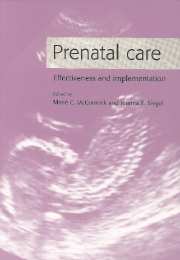Book contents
- Frontmatter
- Contents
- List of contributors
- Foreword
- Acknowledgments
- Introduction
- Part I Prenatal Care and Complications of Pregnancy
- Part II Preventing Prematurity
- Part III New Findings and Long-term Evidence on Intrauterine Growth Restriction
- Part IV Preventing and Treating Birth Defects
- Part V Prenatal Care as an Integral Component of Women's Health Care
- 12 Opportunities for improving maternal and infant health through prenatal oral health care
- 13 Family planning: need and opportunities
- 14 Maternal–fetal conflict is not a useful construct
- 15 Linking prenatal care with women's health care
- 16 A European perspective on prenatal care: an integrated system
- Epilogue
- Index
14 - Maternal–fetal conflict is not a useful construct
Published online by Cambridge University Press: 17 August 2009
- Frontmatter
- Contents
- List of contributors
- Foreword
- Acknowledgments
- Introduction
- Part I Prenatal Care and Complications of Pregnancy
- Part II Preventing Prematurity
- Part III New Findings and Long-term Evidence on Intrauterine Growth Restriction
- Part IV Preventing and Treating Birth Defects
- Part V Prenatal Care as an Integral Component of Women's Health Care
- 12 Opportunities for improving maternal and infant health through prenatal oral health care
- 13 Family planning: need and opportunities
- 14 Maternal–fetal conflict is not a useful construct
- 15 Linking prenatal care with women's health care
- 16 A European perspective on prenatal care: an integrated system
- Epilogue
- Index
Summary
Introduction
The notion that maternal and fetal health can conflict derives from a framework that separates the two and, at times, positions them as adversaries. This construction has its roots in the debate over the legalization of abortion and is the approach taken by ethicists and legal scholars when tackling issues such as the management of a woman who refuses a cesarean. Maternal–fetal conflict has been defined as the situation in which “the intent or actions of the pregnant woman do not coincide with the needs, interests, or rights of her fetus as perceived by her obstetric caregivers” (Cohen, 1995). (The term “caregivers” could be broadened to include the state or any other outside authority with an interest in the outcome of the woman's pregnancy.) While the caregivers believe themselves to be objective advocates for the interests of the fetus, the true interests of the fetus are unknowable. Therefore, the caregivers are conferring their values on the fetus, which is necessarily passive and dependent because it cannot express its interests. Following this logic, the conflict really can be redefined as one between the pregnant woman and her caregivers.
This legalistic approach attempts to quantify the risks and benefits to a woman and a fetus of a particular course of action, and thus separates them, rather than seeing them as an inseparable whole whose well-being needs to be fostered before, during, and after the pregnancy. By necessity, this approach examines only a snapshot in time.
- Type
- Chapter
- Information
- Prenatal CareEffectiveness and Implementation, pp. 285 - 300Publisher: Cambridge University PressPrint publication year: 1999
- 1
- Cited by



